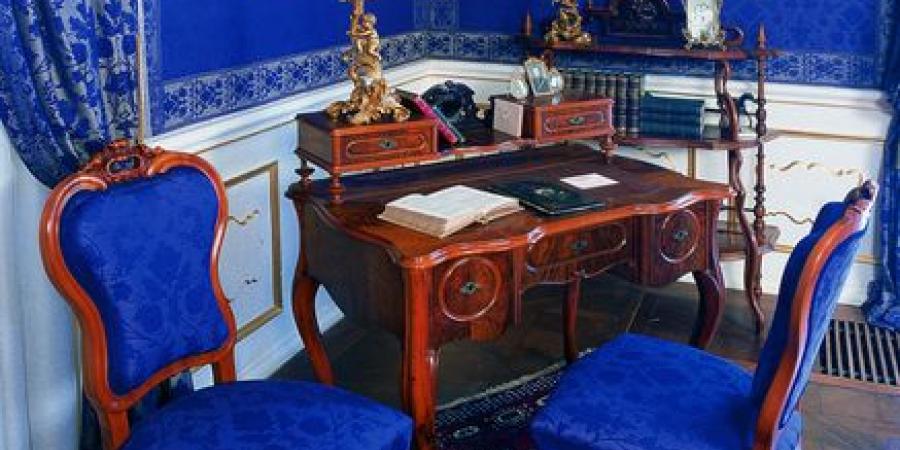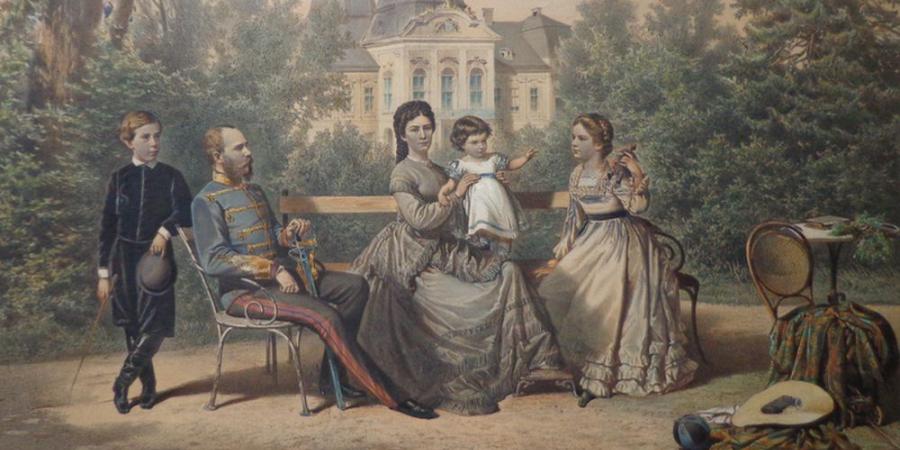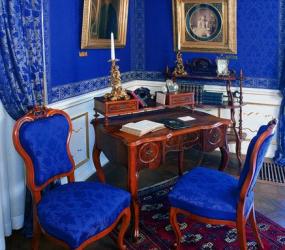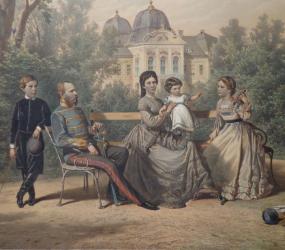Rovatok
Queen Elisabeth's Bathroom and Bedroom in the Royal Palace of Gödöllő
In this paper, I will reveal where Queen Elisabeth's bathroom was furnished in the Royal Palace of Gödöllő, and where exactly the simple iron bed she slept on was set up in her bedroom. Furthermore, I will confirm the fact that Sisi's upstairs suite was connected with a private spiral staircase to the ground floor not only in Schönbrunn Palace but also in the Royal Palace of Gödöllő. The next time you visit the palace, you can also try to find out based on the description below, where Elisabeth's former bathroom could be furnished, and where her iron bed could stand.
It is NOT Elisabeth, neither her Hairdresser in the Photo
Elisabeth did not allow herself to be photographed after the year 1866, when the coronation photo session was taken in the studio of Emil Rabending, one year before the Hungarian coronation. There could be other photos taken in year 1867, but they were taken before her pregnancy with her fourth child, Marie Valerie was visible. (Elisabeth gave birth to Valerie on 22 April 1868. ) However, several speculations were made and some found photos saying that the ageing Elisabeth can be seen in them. Just as in the case of the photo on the right. Why is it not true?
Marie Valerie, the Favourite Daughter of Empress Elisabeth Called our Attention that her Mother’s Nickname is Sisi
The Life and Death of Elisabeth, the Queen Consort of Hungary
A short outline of Elisabeth's relationship to the Hungarians
Elisabeth was the Queen consort of Hungary from 1867 to 1898. She was surrounded by love and worship in Hungary during her lifetime, which increased after her tragic death. We, Hungarians call Elisabeth “Erzsébet”, which was the form she liked to use in her Hungarian conversations and letters. The Queen learnt to speak our language as a native speaker, what is more, she had her fourth child, Marie Valerie taught this language as her mother tongue. It was the language she used when talking to Valerie.
The Life of the Legendary Sisi
Empress Elisabeth of Austria (1854-1898) and Queen consort of Hungary (1867-1898) was surrounded by love and worship in Hungary during her lifetime, which increased after her tragic death. This interest and admiration towards her have not decreased over more than a hundred year. Most people who love Elisabeth got to know her from Ernst Marischka’s Sissi-trilogy of 1950s starring the beautiful actress, Romy Schneider. In Hungary, this popular cult trilogy is on one of the Hungarian TV channels every Christmas remembering, perhaps unwittingly, of Elisabeth's birthday since the Bavarian Duchess was born on 24th December 1837.
CASTLE OF DREAMS
The Hermes Villa, Vienna
The Hermes Villa in the Lainz Game Reserve is the Wien Museum's largest branch location and a place of remembrance of Empress Elisabeth of Austria. In the summer of 1881, Emperor Franz Joseph decided to have a residence built for his wife, Elisabeth in the Lainz Game Reserve. The area of the reserve is in Vienna, not far from Schönbrunn Palace, the summer residence of the Habsburgs. With building the villa, the Emperor’s intention was to urge his wife to spend more time in the Imperial city as well as with him. He wished to spend his old age with her in the Lainz Villa. He wrote to Sisi about his intention in a letter and she was glad about it.
IMPERIAL CHRISTMAS AT VIENNA HOFBURG with Franz Joseph, Elisabeth and their Children
It all happened 130 years ago…
On 16 December 1888, Rudolf and Stephanie had dinner in Hofburg. After the dinner, Elisabeth asked Franz Joseph to entertain her daughter-in-law so as she could speak to Rudolf and Valerie in private in her own apartment. As Valerie wrote in her diary, her mother wanted to “whisper a secret” to Rudolf...
QUEEN ELISABETH’S HUNGARIAN COMPANIONS PART 1 Lili Hunyady and Ida Ferenczy
It is obvious that Sisi felt attracted to the Hungarians since she had chosen Hungarian ladies-in-waiting since the early 1860s, who accompanied her not only to Vienna but also to her journeys. Ida Ferenczy, the Hungarian noble lady was her confidant and one of her closest friends. (...) Her very first lady-in-waiting and confident, Countess Lili (Caroline) Hunyady and her life-long one, Ida Ferenczy, the Hungarian noblewoman.
Eugenie & Elisabeth. The Empresses United in Beauty and Tragedy.
Both regarded as the most beautiful women in the 19th-century Europe, contrary to what may be believed, the empresses shared a similar fate and had plenty in common. However, Empress Eugenie is probably not nearly as popular as Elisabeth, which gives us a wonderful opportunity to introduce her to you.
Article written by Joanna Mirek
WELL-KNOWN THEORIES ARE REFUTED BY THE SISI MUSEUM
The exhibition shows the main events of the Empress’s life by providing several information along with her personal belongings. Besides, as referred above, some well-known theories are refuted in connection with Elisabeth, including the theory about her bad teeth and the fact that she wore only black gowns after her only-son, Rudolf’s death.
IMPERIAL DINNERS IN VIENNA: Invited to dinner by Emperor Franz Joseph
The imperial dining-room in Hofburg gives us a glimpse into the time of the Austro-Hungarian Monarchy. You can see a table set for a formal dinner during Franz Joseph’s time. The Emperor held state banquets, family dinners and military ones. Official dinners, which were started at six o’clock, were held three times a week. About thirty people, mostly high-rank noble men were invited to them. Franz Joseph appeared and took his place at the centre only after all the guest had arrived, but one had to be there on time.
SOME SURPRISING FACTS - “SISSI”: Actors and the Historic Figures
Have you known what are the surprising or somewhat shocking similarities between the life of the historical figures and the leading actors of Sissi?
A LEGEND WAS BORN
“There is nothing more ‘horrendous’ than gradually becoming mummified and unwilling to say farewell to youth. To go about as a rouged larva - dreadful! Perhaps later, I shall always wear a veil, and not even those closes to me will no longer see my face,” said Empress Elisabeth.
A WEDDING PROPOSAL WHICH CANNOT BE REFUSED - What is behind the fairy tale?
The fifteen-year-old Elisabeth and the twenty-three-year-old Franz Joseph met (actually for the second time: they met some years earlier) in a fashionable resort, Bad Ischl on 16th August in 1853, where Duchess Ludovica and her older daughter were invited by Archduchess Sophie. Sophie’s intention was to reintroduce Helene (her chosen one) and Franz Joseph each other. It was the Ludovica’s decision to take Sisi with herself...
A love story you know very well, or not? What could be the first impression of Franz about the young Sisi? Did Elisabeth really love Franz? What is behind the fairy tale?
ELISABETH AND COUNT GYULA ANDRÁSSY - LOVE OR FRIENDSHIP?
Many Sisi-fans regard it as a fact that Empress Elisabeth of Austria and the rebellious revolutionist Count Gyula Andrássy, the so called "handsome hooked", were fallen in love with each other. Some go even further and believe that Sisi’s fourth child, Marie Valerie, who was born in Hungary, was not the Emperor’s but Andrássy’s daughter! Why the rumors are not true? The following article will answer the question.
THE EMPRESS WAS ASSASSINATED
Empress Elisabeth of Austria was assassinated by Luigi Lucheni, an Italian anarchist on 10 September in 1898. Lucheni plotted to kill any member of the elite and oppressive upper class but the one he wanted to murder had to be high ranked and important in order to make the Press write about the event. Lucheni was informed by the daily papers that Empress Elisabeth, another royal highness, is in Geneva under a pseudonym so he hurried to the town to assassinate her without knowing anything about her but the fact that she often refused the aid of police and bodyguards. There is a 6-minute picture-video in the article about her assassination.
The Longest-reigning Emperor of Austria and King of Hungary: FRANZ JOSEPH
“Wait for me at 3:30 a.m., I haven’t quite finished my work” - these were the last words of Franz Joseph, the emperor of Austria according to his valet, Ketterl. The monarch regarded himself as the first officer of the monarchy that was why he was working even while being seriously ill on the day of his death on 21 November 1916.
It was Franz Joseph whose signature ultimately unleashed the World War I and led to the fall of his empire and the Austro-Hungarian Monarchy. Franz Joseph has been dead for a hundred years but his legend lives on.
THE COTILLION - "I think I was dancing with our future Empress"
Sissi Movies and the Reality - One can vividly recall the scene when Sisi enters the ballroom wearing light blue prom dress with a glittering diamond arrow in her hair to the amazement of Franz. Helen - like on the screen- was wearing a beautiful white silk dress; however, Sisi’s dress was much more modest. She was wearing a simple peach tulle or a rosy white muslin prom dress, which was prepared not long before their departure from Possenhofen. However, the jewel was in her hair just like on the screen: those who attended the ball could see the glittering small diamond arrow which pushed back "the brown gold waves from her forehead" (Corti, 21).
THE GIFT OF THE RECONCILIATION - 150th Anniversary of the Austro-Hungarian Compromise of 1867
This year is the 150th anniversary of the foundation of the Austro-Hungarian Dual Monarchy and the coronation of Franz Joseph and Elisabeth in Budapest. The young emperor ruled in a neo-absolutist and authoritarian fashion, but in many regions of his multi-national empire the desire for autonomy was growing. His wife Elisabeth had great sympathy for the Magyars (Hungarians) and lent her support to endeavours to reintroduce the old constitution. Her emotional speeches given in Hungarian and her contacts with liberal Hungarian politicians eventually led to the coronation of Franz Joseph and Elisabeth as king and queen of Hungary in June 1867.
THE VIENNA HOFBURG: Sisi Museum, Imperial Apartments, Imperial Silver Collection
For many centuries the Vienna Hofburg was the centre of the Habsburg Empire. Today three museum attractions provide visitors with historically authentic insights into court tradition and daily life: the Imperial Apartments with their historically authentic decoration and furnishings, the Imperial Silver Collection with its extensive holdings of objects that recreate the sumptuous world of imperial dining, and the Sisi Museum with its lyrical exploration of the empress’s life which celebrated its tenth anniversary in 2014.
THE GRANDDAUGHTER OF AN EMPRESS
The last pregnancy. It was the same suffer as the previous ones as regards her inner world. However, she loved that one, the child who was really her own, who she was fighting for not letting any other women care about this one as it happened in the case of the previous ones. This child was hers. She felt it. But enough was enough. She no longer wanted to bear more babies. She was looking at her rounded belly, in which a new life was developing. She did it for her husband. She had to allow him once again although she felt she would have died instead of carrying another child. She was stubborn and obstinate just like her beloved grandmother.
SCHÖNBRUNN PALACE AND ITS GARDEN
The World Cultural Heritage Site of Schönbrunn Palace is Austria’s most frequently visited tourist attraction. In the ownership of the Habsburg dynasty for centuries, this Baroque ensemble of palace and gardens has been preserved largely in its original state. Numerous attractions await the visitor, including tours of the authentically furnished state rooms and residential apartments of the imperial family in the palace, to the Maze and Labyrinth in the gardens and a dedicated Children’s Museum.
ELISABETH’S GARDROBE: Sisi’s Favourite Colours
Elisabeth had her dresses designed in accordance with her own style, which was dependant on a delicate taste and not on the actual fashion. Not only the Viennese court companies but also the most elegant Parisian tailor, Worth made her dresses, furthermore, she frequently had clothes delivered by Hungarian fashion companies as well.
What were her favourite colours and colour combinations? Why was she fond of black? The following article is going to answer all of these questions as well as many others and is going to enlighten many others which you might not have read about yet.
THE EXCITING LIFE OF MARIE SOPHIE, SISI’S YOUNGEST SISTER
After losing her children, Mary was inconsolable and suffered terribly. She wanted to annul her marriage to her husband, with whom, except praying together, did not do anything in common. Count Lawayss made several attempts to get back his precious love, Marie Sophie, however, Maximilian II, King of Bavaria hired agents to prevent it. Finally, Marie, following her family’s advice, wrote her husband and made a confession. Francis, the (ex)king of Naples forgave her then soon he underwent a medical intervention.
ON THE TRAIL OF EMPRESS ELISABETH
It is very surprising for the Hungarians that in her homeland and all around Europe she did not use to be as popular and admired during her lifetime as in Hungary, what is more, little interest was shown towards her then. However, she gained popularity several decades after her a tragic death. As Katrin Unterreiner says “there has hardly ever been a monarch stylised posthumously to such iconic status as Empress Elisabeth.” She “did not become an international marketed product with romaticised biography and entwined by legend until long after her death". It was not only her violent death but also the movie which surrounded her by the aura of a myth.
THE EMPRESS LOVED HER DOGS
Elisabeth undoubtedly loved her dogs, which followed her through the rooms of her homes. She even had a lot of photographs taken and paintings made of her favourite ones. The Empress had more photos with her dogs than with her nuclear family. It is important to note that Elisabeth had more photos even with her siblings than with her husband or children.
SISSI MOVIES AND THE REALITY - INTRODUCTION
Ernst Marischka’s Sissi films reflect the taste of the Austrian public of the 1950s. The aim of the trilogy was making the audience forget about the horrors of the Second World War while watching it. Since then, it has been one of the most successful German-speaking film of the world.
Sissi (1955) is the first part of the trilogy, which is followed by two sequels, Sissi - The Young Empress (1956) and Sissi - Fateful Years of an Empress (1957). The fourth part was also planned, however, Romy Schneider refused to be the young Empress Sissi again.
SISSI OR SISI OR LISI?
Unfortunately, it is true that in many places of Hungary and other parts of the world her nickname is spelt like that. It is incorrect. I would like to highlight the fact that in her “homeland” Austria (I mean the homeland of the Empress and not that of the Bavarian Duchess) her nick is "Sisi".
SISI’S YOUNGEST SISTER, "THE WARRIOR QUEEN”
Bavarian Duchess, the last Queen Consort of Naples - the Kingdom of the Two Sicilies (4 October 1841 - 19 January 1925) - PART 1
The story of a marriage which was consummated only ten years after the match. However, meanwhile, the young wife gave birth to twins, of course, secretly...
THE DAILY LIFE OF THE ROYAL FAMILY IN GÖDÖLLŐ
In Gödöllő, Elisabeth’s daily routine was the following: She got up at six or seven o'clock in the morning, which was followed by grooming, her daily exercises and a bath (she had a daily bath). After that her several-hour long combing and dressing session came. Then she went riding or walking. After having returned, she had a modest meal and read for a while. When she was older and could not ride a horse due to her joint problems, she went for larger walks.She only returned to the dinner when the family ate together.
ELISABETH’S BEAUTIFYING BATHS
The article includes imperial beautifying bath recipes from the book of Chris Stadtländer, which has not been translated into English yet.
Elisabeth, who was very famous for her beauty cult, had refreshing and slimming baths daily in order to preserve her beauty and youth. She combined steam and hot bath with cold one. She especially liked warm olive oil to make her skin delicate. The Empress’ niece, Countess Wallersee witnessed and recorded a case when her aunt nearly sacrificed herself on the altar of beauty...
ELISABETH AS A YOUNG WIFE AND MOTHER
The rooms of the Empress’ children cannot be visited during our walk in the imperial suites in Hofburg since they were located very far from her rooms. The first three children were departed from her (Elisabeth’s first daughter, Sophie died of dysentery in Buda) by her anti-Hungarian mother-in-law. However, it must be noted that Sisi was very happy about her child after her birth! She did not feel lonely, instead, she was overjoyed. She became terribly desperate after Sophie took away her (and later the other ones too). She had the same kind of feelings as it appears on the screen in the film Sissi. What is more, it was even worse. She cried a lot.
THE PORTRAIT OF A QUEEN
Soon after that I heard footsteps. I backed quickly, however, it was too late. She was standing in front of me wearing a dark blue riding dress trimmed with fur, which fitted her tall and slender figure perfectly. The way the hat was sitting on her head made her so gentle and royal. She was holding a white lace fan in her hands, which were covered by thick white gloves. I bowed deeply. I did not dare to look up. I felt my face getting redder and redder due to the shame. Puzzled I was. The novel fell out of my shaking hands. She did not say anything for half a minute then she told me quietly,
ROMY, THE EMPRESS
“For the audience I have always been SISSI, the embodiment of Her charming, innocent Imperial Highness. Apparently, it was only me who was fully aware that I was not any SISSI. I played her, that’s true, but in reality I do not bear even the slightest resemblance to this fairy-tale princess”.
Romy Schneider
THE YOUNGER BAYERN DUCHESS, WHO FITTED THE BLACK BETTER
Ludovica, Helene and Sisi were wearing mourning dresses because of the death of an aunt. The simple, highly closed black dress fitted Sisi perfectly but Helene seemed to be too strict in that. According to many, it also played a role in the Emperor’s choice, and that is why his marriage proposal was made so quickly...
THE WEDDING NIGHT AND WHAT WAS LEFT OUT OF THE FILM SISSI
Their wedding ceremony and all about that were gorgeous and met the protocol requirements. However, even the Emperor's mother, Archduchess Sophie, did not consider that the same should be continued on the way to the master bedroom although in the European royal courts of the nineteenth century it was still in fashion - the bride and the bridegroom were accompanied to the bedroom by members of the court. Sisi was accompanied only by her mother-in-law, Archduchess Sophie and her mother, Ludovica then she was left alone.
WHAT HAPPENED TO THE YOUNG SISI AT THE WEDDING NIGHT – OR WHAT NOT…?
The Emperor, in most of the cases, behaved generously and tactfully with his wife. However, Franz Joseph was introduced to the sexuality by countesses, and it can be questioned whether he could be enough tender and patient with the young and inexperienced Sisi. Probably not, because Elisabeth was not fond of sex either at the early stage of their marriage or later.
THE HUNGARIAN PRINCESS: MARIE VALERIE
Why was an Austrian Archduchess forced to talk in Hungarian and use this language as a mother tongue?
Born by a Bavarian mother and an Austrian father Marie Valerie was brought up as a Hungarian princess. Although her mother tongue was German, her first language was Hungarian and it was the one she used while talking to her mother, Queen Elisabeth and her father, King Franz Joseph. Archduchess Marie Valerie of Austria (22 April 1868 – 6 September 1924) was the fourth and last child of Emperor Franz Joseph of Austria and Elisabeth of Bavaria. Her given name was Marie Valerie Mathilde Amalie but she was usually called Valerie.
THE LAND OF QUEEN ELISABETH
The atmosphere of Gödöllő Court resembled to that of Possenhofen one, where Elisabeth spent her pretty happy childhood. The atmosphere was very intimate in the Hungarian estate. However, Franz Joseph, who came from a rigid and ritual-lover family due to his upbringing, was not used to it. In this atmosphere the spouses got closer to each other because they could spend time together freely on their common passions: love of nature, horse riding and hunting.

















































































